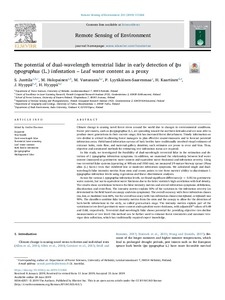The potential of dual-wavelength terrestrial lidar in early detection of Ips typographus (L.) infestation – Leaf water content as a proxy
Junttila S.; Holopainen M.; Vastaranta M.; Lyytikäinen-Saarenmaa P.; Kaartinen H.; Hyyppä J.; Hyyppä H.
https://urn.fi/URN:NBN:fi-fe2021042713655
Tiivistelmä
Climate change is causing novel forest stress around the world due to changes in environmental conditions. Forest pest insects, such as Ips typographus (L.), are spreading toward the northern latitudes and are now able to produce more generations in their current range; this has increased forest disturbances. Timely information on tree decline is critical in allowing forest managers to plan effective countermeasures and to forecast potential infestation areas. Field-based infestation surveys of bark beetles have traditionally involved visual estimates of entrance holes, resin flow, and maternal-gallery densities; such estimates are prone to error and bias. Thus, objective and automated methods for estimating tree infestation status are required.
In this study, we investigated the feasibility of dual-wavelength terrestrial lidar in the estimation and detection of I. typographus infestation symptoms. In addition, we examined the relationship between leaf water content (measured as gravimetric water content and equivalent water thickness) and infestation severity. Using two terrestrial lidar systems (operating at 905 nm and 1550 nm), we measured 29 mature Norway spruce (Picea abies [L.] Karst.) trees that exhibited low or moderate infestation symptoms. We calculated single and dual-wavelength lidar intensity metrics from stem and crown points to test these metrics' ability to discriminate I. typographus infestation levels using regressions and linear discriminant analyses.
Across the various I. typographus infestation levels, we found significant differences (p < 0.05) in gravimetric water content, but not in equivalent water thickness due to the latter statistic's high correlation with leaf density. The results show correlations between the lidar intensity metrics and several infestation symptoms: defoliation, discoloration and resin flow. The intensity metrics explain 50% of the variation in the infestation severity (as determined in the field based on canopy and stem symptoms). The overall accuracy with three infestation classes (no, low, or moderate) was 66%, but the overall accuracy with two infestation classes (not infested, or infested) was 90%. The classifiers combine lidar intensity metrics from the stem and the canopy to allow for the detection of bark-beetle infestations in the early, so called green-attack stage. The intensity metrics explain part of the variations in tree-level gravimetric water content and equivalent water thickness, with adjusted R2 values of 0.48 and 0.68, respectively. Terrestrial dual-wavelength lidar shows potential for providing objective tree-decline measurements at tree level: this method can be further used to enhance forest inventories and automate tree-vigor data collection, which has traditionally required expert knowledge.
Kokoelmat
- Rinnakkaistallenteet [27094]
